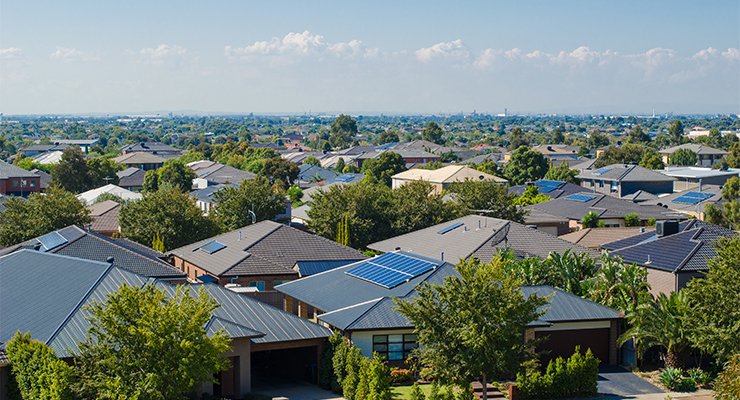
Rents have crossed a significant threshold.
Only 16% of places available to rent nationwide in April could be had for $400 a week, down from 30% a year ago, according to new analysis by PropTrack. In the capital cities, the decline is even more acute: from 36% to 12%.
Nota bene: $400 is the advertised price. As mentioned in these pages recently, rents paid for a newly leased property can be higher than the advertised price as renters “bid up” by offering more money to secure the property.
The $400-a-week threshold is significant. The JobSeeker payment is $693.10 a fortnight. The aged pension is $971.50 a fortnight. If there are not market rentals at less than $400 a week more recipients will be in financial stress, even with the modest additional payment of Commonwealth rent assistance (a maximum of $78.60 a week).
High rents create poverty and homelessness. They also cause the Reserve Bank (RBA) to leave interest rates higher than they would otherwise be.
Rising rents are set to be the nation’s biggest source of inflation before long — the final dragon the RBA needs to slay. Why? Rents contribute to the CPI with a lag. The Bureau of Statistics measures rents actually paid, and that is quite different from advertised rents, because some people locked in their rent a year ago or indeed possibly several years ago.
Advertised rents are through the roof with double-digit growth. But rents paid are still only creeping up at 4.9% a year. Over time though, tenants move and the stock of rental homes is leased at the new higher market price. Instead of a sharp spike in measured rent inflation, we get a slow burn. Our inflation may not have peaked like the US but it is likely to drag on longer. That’s certainly what the RBA predicts, with forecasts of inflation still above 3% in mid-2024.
What can you get for $400?
The first time I paid rent was in a sharehouse in 2005. We got a four-bedroom house in a nice suburb of Canberra for $440 a week or so. Each housemate was on the hook for about $110 a week; one a little more because she had an ensuite; one a little less because his room was tiny.
Since then, rents have risen everywhere. But as the next chart shows, not in the way you might expect. Rents rose very quickly between 2006 and 2012, but between 2014 and 2020 flatlined in many places. (Hobart the notable riser, Perth and Darwin saw big falls.) In total, rents have not quite doubled since 2005 nationwide.
While Canberra has seen strong rent inflation, I just checked and you can rent a four-bedroom house in the same street of Canberra for only about 50% more than what we paid some 18 years ago. Perhaps that’s one where the agent is expecting prospective tenants to bid it up!
Why didn’t rents rise relentlessly?
All those cranes on the skyline in Australia’s biggest cities meant we built a decent number of houses throughout the period. Between 2015 and 2018 Australia built a lot of houses but also a lot of apartments. That kept the rental market in check, and the surge really only ended with the 2017-18 house price correction.
Now the situation is different, with a paucity of new apartments being started over the past 18 months, thanks to rising interest rates and falling home prices. That means few new apartment towers for international students and other migrants to move into as they arrive.
Advertised rents are skyrocketing because of very low rental vacancies.
People are arriving in Australia in numbers. Just focusing on permanent migrants misses the impact on the rental market. The 100,000 people who showed up in February declared themselves long-term visitors (mostly international students; far more than the 12,000 or so who are arriving as permanent migrants). The long-term visitors’ category spikes twice a year, in February and August, as classes start.
We might get a bit of breathing space in the rental market until August, with a lull in rises in advertised prices. There might still be a few places for $400 or less. But in August, expect a $400 rental to become almost a myth.








How many houses/apartments are used for short term rentals like Air BnB?
If they are used exclusively for short term rentals, shouldn’t they be treated as hotels – requiring that the property be classified as commercial?
Perhaps these short term rentals should be limited to a person’s primary residence and can only be leased out 4 weeks in a year.
This is a good question. Even if only 50% of short-break accommodation (Air B&B is just one offender) returned to the long-term rental market, I suspect that a considerable chunk of this issue would disappear. Anyone got any stats on this? I’m serious.
Byron shire is trialling 8 weeks holiday rentals per year for dwellings where the owner doesn’t live on the property. I personally don’t it’ll make any difference as rentals are sky high anyway. $400/week won’t get you anything there.
There are ideas and opinions that can’t be spoken or written about in today’s version of The Polite Society. First cab off the rank is Breeding Licences.
Some background: I am a devotee of the Yes Minister and Yes Prime Minister TV series. In total there were 37 episodes (21 and 16 respectively), and I’ve watched them so many times that I just about know them off by heart. To make sure that my 70 year old brain remembers them, I religiously jot down every particularly sharp and hilarious statement from the show. (In saying that please bear in mind that possibly the best line of all came from Jim’s private secretary Bernard Woolley who, when asked who The Sun newspaper would prefer as Prime Minister, replied: “The Sun readers don’t care who’s Prime Minister, as long as she’s got big tits!”
Breeding licences. One Yes Prime Minister episode brought up the problems of the masses of poor people in public tenements, and their higher than average tendency to produce children who broke the law.
“Perhaps we should issue breeding licences!” Hacker roared, to the laughter of Bernard, Sir Humphrey and political adviser Dorothy. Not the laughter of agreement, but the laughter of “We intellectually superior folk realise that it’s a logical idea to limit the growth of the underclasses, but there’s no way it would get past the namby-pamby gatekeepers.” Despite the snobbery oozing from these toffs towards people in unfortunate circumstances, they considered the idea preposterous – but only because they knew it would never get up.
Australia currently has a housing crisis. Homeowners with negative gearing-enabled additional properties, who were already on a very good wicket in renting, on a long-term basis, to families, got greedy. Realising that they could increase their rental income by around 1,000 percent if they changed to short term (air bnb), these hundreds of thousands of – on the surface – ‘good, ordinary Australians’ followed the market Gods and started kicking families out on to the street. Decades of governments (of either side) encouraging and leading (by example) us towards a land of greed, whilst being happily married to a racist and dismissive attitude towards (for example) Indigenous Australians, refugees and poor people.
Breeding licences shouldn’t be foisted upon poor people – but they should be stuffed down every Gucci jockette-wearing/‘successful businessman’/good old Aussie landlord/politician’s pants.
Until, that is, they get their big heads together and divide the big pie up more fairly. No more kids for the comfortably off until there are no more families of five sleeping in wet tents.
Interesting analysis and raises some questions including the writer’s share house experience, post Covid dynamics, seasonality, highish inflation (chicken or egg?) and ‘Advertised rents are skyrocketing because of very low rental vacancies’.
It’s difficult to gain a detailed picture of accommodation, with a diverse population inc. temporaries, especially from the granular grass roots up to the headline data; it’s very diverse and complex while we rely on industry PR masquerading as data (seasonal or cyclical scare campaigns spruiking undefined immigration &/or ‘population growth’) using headline data.
Sharing itself is a massive grey area, i.e. word of mouth for mass of young people, overseas and/or local, then also relying upon ‘advertised’ rentals &/or sales via our FIRE media complex.
Good examples are CBD apartments, when you walk past a real estate agency in the CBD, see many adverts in their windows, but you often cannot find the same advertised in FIRE media, which many analysts rely on?
Further, while media focuses upon higher priced ‘houses’, median values have stagnated (using 7% rule), apartments attract criticism, but anecdotally one is aware that many younger Australians working CBD or inner city, rent apartments, walk to work and access inner city ‘vibrancy’, eminently sensible?
One million houses empty on census night! Put them on the market and there is no longer a housing problem